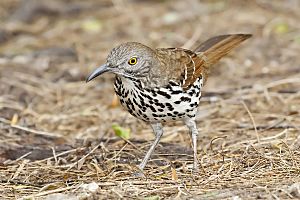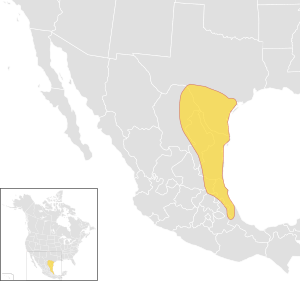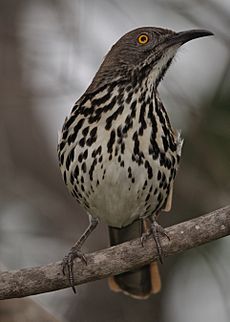Long-billed thrasher facts for kids
Quick facts for kids Long-billed thrasher |
|
|---|---|
 |
|
| at Laguna Atascosa National Wildlife Refuge, Texas | |
| Conservation status | |
| Scientific classification | |
| Genus: |
Toxostoma
|
| Species: |
longirostre
|
 |
|
| Long-billed thrasher range | |
| Synonyms | |
|
Orpheus longirostris |
|
The long-billed thrasher (Toxostoma longirostre) is a medium-sized songbird. It lives all year in South Texas and eastern Mexico. This bird looks very much like its close relative, the brown thrasher. They share similar looks, calls, and behaviors. However, these two species usually live in different areas. Brown thrashers only visit the long-billed thrasher's northern range in winter.
This bird is a large mimid, which is a type of bird known for mimicking other birds' songs. It is not very shy. It takes steps to avoid becoming prey. Like other thrashers, it gets its name from how it sweeps the ground to find food. It does not get its name from "thrashing" predators. But these birds are very aggressive when defending their homes.
Contents
Understanding Long-billed Thrasher Taxonomy
Taxonomy is how scientists classify living things. The scientific name for this bird is Toxostoma longirostre. The second part, longirostre, comes from Latin words. Longus means long, and rostrum means bill. So, its name means "long bill."
There are two types, or subspecies, of the long-billed thrasher.
- T. longirostre ssp. longirostre was first described by Frédéric de Lafresnaye in 1838. This subspecies lives in eastern Mexico. You can find it in states like Querétaro, Tamaulipas, Veracruz, and Puebla.
- T. longirostre ssp. sennitti was described by Robert Ridgway in 1888. It is also called Sennett's thrasher. This one lives from southern Texas down to the Lower Rio Grande Valley. It also lives in the Mexican states of Tamaulipas and San Luis Potosí.
The long-billed thrasher, brown thrasher, and Cozumel thrasher are very closely related. Scientists group them together because of their similar feathers and bill shapes. Genetic studies also show they are related.
What Does a Long-billed Thrasher Look Like?
This bird is slender and has a long tail. It is about 26.5 to 29 centimeters (10.5 to 11.5 inches) long. It weighs about 70 grams (2.5 ounces). It is similar in size to the American robin.
The T. longirostre ssp. sennitti has a grayish-brown head. Its back, rump, and shoulders are a reddish-brown color. Its wings have broad white tips. The main wing feathers are dull brown with reddish-brown edges. This makes the folded wings look reddish. Its chin, throat, chest, and belly are white or pale white. The chest and belly have clear black oval spots. The underside of its wings is buffy-white. Its eyes are usually orange or orange-yellow. Its bill is dull brown, with a pinkish-grey base on the lower part.
The T. longirostre ssp. longirostre is similar but smaller and darker. It has a reddish tint and buffy-white underparts. Young thrashers have dusty streaks on their rump. Their undertail feathers are buffy-white.

How to Tell it Apart from Similar Birds
The long-billed thrasher looks a lot like the brown thrasher. But there are some differences. The long-billed thrasher's face is grayer. The brown thrasher's face looks more reddish. The long-billed thrasher's underparts are whiter and less buffy. Its eye looks more orange and stands out more. Its bill is usually longer and blacker. Overall, the long-billed thrasher has more contrast in its feather patterns.
The sage thrasher also lives in some of the same areas. However, it is smaller and grayer. Its tail feathers have a more noticeable white color.
Where Long-billed Thrashers Live and Their Homes
This bird lives in southern Texas, as far north as San Antonio. It also lives south through northwestern Mexico to central Veracruz. Its range extends east to eastern Coahuila, San Luis Potosí, and Hidalgo. The most long-billed thrashers live in the Lower Rio Grande Valley.
A lot of their natural home in the Rio Grande Valley was lost. This happened because land was cleared for farming. So, the number of these birds in that area went down from the 1930s to the 1970s. However, some human activities have created new suitable places for them. This has helped the species. It is still a common bird in its range. In Texas, there is some evidence that their living area has expanded north and east. This has happened over the last five decades (1957-2007). Scientists think climate change might be a reason for this. Except for a few birds seen in New Mexico and Colorado, these birds stay in their home range all year.
Long-billed Thrasher Behavior
Long-billed thrashers usually stay hidden on or near the ground. But they might sing from high places where they can be seen. When they look for insects on the ground, they quickly turn over leaves and other debris. This is called "thrashing." They can also be seen singing from exposed spots above their thorny bush homes. Males usually sing from March until mid-summer. They might sing short songs at other times of the year too.
These birds are generally not shy. This might be because they are hard to get close to. Their flights are usually low to the ground, short, and a bit jerky. They also have exaggerated up-and-down movements. Long-billed thrashers are strong defenders of their homes. They will fiercely protect their nests, even from humans. The longest a long-billed thrasher has been known to live was 7 years and 3 months. This bird was found in Alamo, Texas, in 1965.
Voice and Songs
The long-billed thrasher's song is warbling. It sounds like other thrashers' songs. But it is especially rich and musical. Sometimes it can sound a bit scratchy. They often repeat phrases two to four times. A special call is a loud, rich whistle that sounds like cleeooeep. Other calls include a mellow, whistled tweeooip or ooeh. They also make a loud, sharp chak sound. A very fast, sharp rattle sounds like chtttr. They also make tsuck and verrs sounds during fights over territory. These sounds are similar to those made by their close relative, the brown thrasher.
Reproduction and Life Cycle
Long-billed thrashers usually build their nests in thick plants. They prefer spiny shrubs and trees. This helps keep their nests safe from predators. Nests have also been found in plants like willows, mesquite, huisache, cacti, or yucca.
The nest is a bulky cup shape. It is placed in thick, low, or medium-height plants. They build it from twigs, straws, and grasses. The female lays 2 to 5 eggs. The eggs are bluish-white with many reddish-brown and gray speckles. They look exactly like brown thrasher eggs. Most eggs are laid in April and May in Texas. In Mexico, they are laid in May and June. Sometimes, eggs are laid as late as June in Texas and July in Mexico. The eggs hatch over 24 days. Unlike most thrashers, all the eggs hatch at the same time. Both parents take turns sitting on the eggs, which is called incubation. This lasts 13 or 14 days. Both parents also feed the young birds after they hatch. These birds are rarely tricked into raising the young of other birds, like the brown-headed cowbird or bronzed cowbird.
What Long-billed Thrashers Eat
To find food, the long-billed thrasher looks on the ground. It quickly sweeps its bill from side to side. This tosses leaves and other debris up and behind itself. Then it scratches the ground for food. Their diet includes small creatures without backbones. These are things like grasshoppers, beetles, and other insects. They also eat crustaceans (like tiny crabs) and snails. They also eat a good amount of plant material, especially berries.
Images for kids
See also
 In Spanish: Cuitlacoche piquilargo para niños
In Spanish: Cuitlacoche piquilargo para niños




